HOME
ANIMALS
REPTILE
Turtles
From Compton's Interactive
Encyclopedia © 1999 The Learning Company, Inc.
Most Images From Micorsoft
© Encarta 99 ©
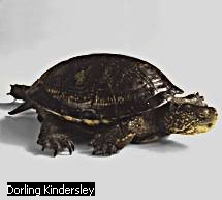 Along
with snakes, lizards, and crocodiles, turtles belong to the class of
animals called reptiles. The
earliest fossils recognized as turtles date from the Triassic
period, about 200 million years ago; thus, turtles were in existence
prior to the emergence of the great dinosaur groups.
Turtles have changed little in appearance since that time.
Along
with snakes, lizards, and crocodiles, turtles belong to the class of
animals called reptiles. The
earliest fossils recognized as turtles date from the Triassic
period, about 200 million years ago; thus, turtles were in existence
prior to the emergence of the great dinosaur groups.
Turtles have changed little in appearance since that time.
World Distribution
About 250 species of turtle
are found throughout the temperate and tropical regions of the world,
including the major seas. In contrast to other reptiles, whose
populations are confined largely to the tropics, turtles are most
abundant in southeastern North America and southeastern Asia. They
live in lakes, ponds, salt marshes, rivers, forests, and even deserts.
Anatomy
Sizes
The size of turtles varies.
Bog or mud turtles grow no larger than about
4 inches long.
The sea-roving leatherback turtle, however, may be as much as 8
feet in length and weigh 1,200 pounds.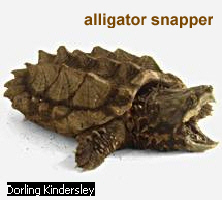 Alligator snappers of the southeastern United States
Alligator snappers of the southeastern United States  reach weights of more than 110 pounds. They are among the largest
freshwater turtles. Land-dwelling species are often called tortoises.
In the United States some edible turtles are called terrapins.
reach weights of more than 110 pounds. They are among the largest
freshwater turtles. Land-dwelling species are often called tortoises.
In the United States some edible turtles are called terrapins.
Shells
Turtles have protective
shells. The upper, arched part is called the carapace; the flat
bottom part is the plastron. Some species, such as the box turtle,
can withdraw the head, legs, and tail and tightly close the hinged
front and back halves of the plastron for protection. The snapping
turtle, however, has a small plastron that does not cover its
underside. Powerful jaws and claws are the snapping turtle's best
defense against enemies. Sea turtles also are unable to retreat
completely inside their shells. Side-necked turtles have necks that
are too long to tuck into their shells. Hence, the neck folds
sideways along the inner edge.
The carapace is made of
backbone and ribs joined together with plates of bone. The plastron
is fused with the breastbone. In hard-shell turtles the bone is
covered with horny shields. The markings and colors of these shields
vary with the type of turtle. The hawksbill sea turtle yields most of
the tortoise shell from which 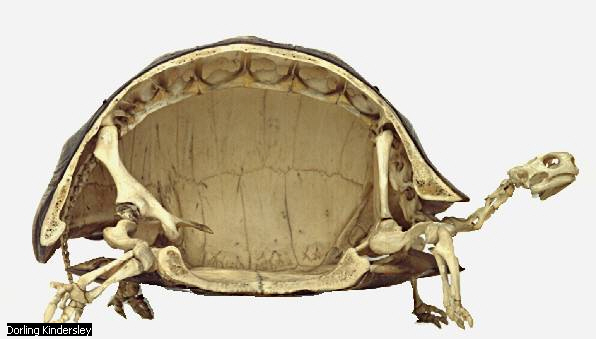 ornamental
articles such as combs and brush handles were once made. Soft-shell
turtles have a layer of tough skin that covers the bony shell and
looks like a leathery pancake.
ornamental
articles such as combs and brush handles were once made. Soft-shell
turtles have a layer of tough skin that covers the bony shell and
looks like a leathery pancake.
Senses
Turtles have keen eyesight
and well-developed senses of smell and taste. They have no external
ear openings, so they do not hear well. Most turtles make no sounds
other than a hiss when they become alarmed.
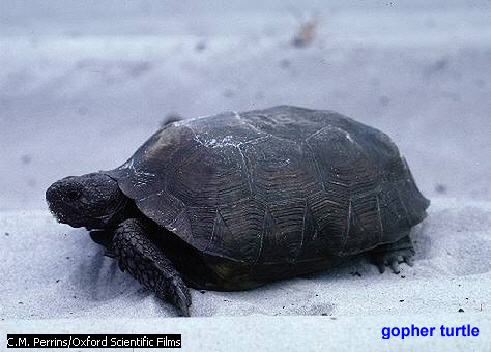
The gopher tortoise with its
unwebbed, stumpy feet, is an accomplished digger. Burrows that may
extend 35 feet underground provide the turtle-and other animals-with
relief from extreme heat or cold. The gopher tortoise may share its
home with, among other guests, mice, gopher frogs, insects, burrowing
owls, opossums, or diamondback rattlesnakes. The burrow is often
mistakenly attributed to an actual gopher.
C.M. Perrins/Oxford
Scientific Films
Legs and Feet
Terrapins differ from the sea
turtles in that their legs are not modified into paddles but instead
have webbing and claws.
The legs and feet of most
turtles are adapted for walking on land, and the webbing between
their toes helps them swim. Their toes have claws. Like elephants,
tortoises have column-shaped legs that support their large bodies on 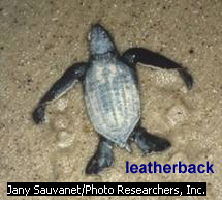 land.
Sea turtles have flippers for front feet.
land.
Sea turtles have flippers for front feet.
Behavior
Temperate zone turtles
retreat to the bottom of lakes and streams or bury themselves in the
soil during cold periods. They can raise their body temperature,
however, by basking in direct sunlight. All
turtles breathe with lungs, but some species can respire through
certain tissues of the throat, skin, and anal region while under water.
Some can go for long periods without breathing air directly.
Eating Habits
Turtles have no teeth. They
use their sharp beaks to tear food into pieces that are then
swallowed whole. Turtles eat living or dead plant and animal matter,
but some turtles are specialized feeders. Some river turtles feed on
clams and mussels. Jellyfish form a major portion of the diet of the
leatherback turtle. Many tortoises eat only living plants. Turtles
can store food in the form of fat, and they store water in
specialized bladders.
Reproduction
All turtles go ashore to lay
eggs. A nesting female digs a hole with her hind feet and drops the
eggs into it. After covering the opening and packing down the soil,
she 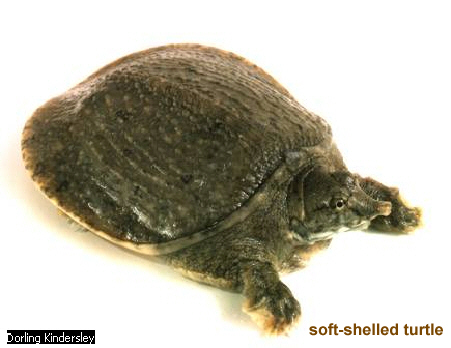 departs
from the nest immediately. She neither cares for the eggs nor
nurtures the young. The eggs are white and vary in shape from oblong
to round, depending on the species. The mud and musk turtles lay
oblong eggs that are less than 1 inch long with a rigid shell
composed of calcium carbonate, similar to a bird's egg. The shells of
most other species, however, are leathery and tough. The large, round
eggs laid by sea turtles and tortoises are more than 2 inches in
diameter. For most
species, the temperature at which an egg incubates determines the sex
of the hatchling. Higher temperatures generally produce a female,
while cooler temperatures produce a male.
departs
from the nest immediately. She neither cares for the eggs nor
nurtures the young. The eggs are white and vary in shape from oblong
to round, depending on the species. The mud and musk turtles lay
oblong eggs that are less than 1 inch long with a rigid shell
composed of calcium carbonate, similar to a bird's egg. The shells of
most other species, however, are leathery and tough. The large, round
eggs laid by sea turtles and tortoises are more than 2 inches in
diameter. For most
species, the temperature at which an egg incubates determines the sex
of the hatchling. Higher temperatures generally produce a female,
while cooler temperatures produce a male.
While the shells of other
turtles have a horny outer layer, those of the 21 species of
soft-shelled turtles are covered by a leathery skin. Their beaks,
too, sport a pair of fleshy lips that belie the strength and speed of
their jaws. All species of soft-shelled turtles are aquatic. They
swim powerfully with paddlelike legs, pushing their tubular noses out
of the water for air. Soft-shelled turtles are native to Asia,
Africa, and North America.
Dorling Kindersley
The incubation period
for some turtle eggs is less than 45 days. For others it is more than
100 days. Some turtles produce only one or two eggs per clutch, but
sea turtles may lay more than 100 eggs at a time. The incubation
period for some turtle eggs is less than 45 days. For others it is
more than 100 days. Some turtles produce only one or two eggs per
clutch, but sea turtles may lay more than 100 eggs at a time.
Life Expectancy
Turtles reach maturity in
about 3 to 8 years or more. The
females of some species may become twice as large as the males.
Turtles live longer than most other animals, but reports of turtles
living more than a century are questionable. Several kinds, however,
have lived more than 50 years in captivity. Even in natural
environments, box turtles and slider turtles can reach ages of 20 to
30 years. The ages of some turtles can be estimated by counting the
growth rings that form each year on the external bony plates of the shell.
Some turtles are popular as
pets, but the sale of small ones has been made illegal in the United States.
Turtle eggs and meat are
eaten in many regions of the world. In the United States certain
species are harvested for sale to restaurants. Collecting and
harvesting have greatly reduced the numbers of many native species
such as the snapping turtle. Aquatic turtles are useful scavengers in
both natural and man-made lakes. Many
turtle species, such as most tortoises and sea turtles, have been
placed on lists of threatened and endangered species.
 Along
with snakes, lizards, and crocodiles, turtles belong to the class of
animals called reptiles. The
earliest fossils recognized as turtles date from the Triassic
period, about 200 million years ago; thus, turtles were in existence
prior to the emergence of the great dinosaur groups.
Turtles have changed little in appearance since that time.
Along
with snakes, lizards, and crocodiles, turtles belong to the class of
animals called reptiles. The
earliest fossils recognized as turtles date from the Triassic
period, about 200 million years ago; thus, turtles were in existence
prior to the emergence of the great dinosaur groups.
Turtles have changed little in appearance since that time. Alligator snappers of the southeastern United States
Alligator snappers of the southeastern United States  reach weights of more than 110 pounds. They are among the largest
freshwater turtles. Land-dwelling species are often called tortoises.
In the United States some edible turtles are called terrapins.
reach weights of more than 110 pounds. They are among the largest
freshwater turtles. Land-dwelling species are often called tortoises.
In the United States some edible turtles are called terrapins. ornamental
articles such as combs and brush handles were once made. Soft-shell
turtles have a layer of tough skin that covers the bony shell and
looks like a leathery pancake.
ornamental
articles such as combs and brush handles were once made. Soft-shell
turtles have a layer of tough skin that covers the bony shell and
looks like a leathery pancake.
 land.
Sea turtles have flippers for front feet.
land.
Sea turtles have flippers for front feet. departs
from the nest immediately. She neither cares for the eggs nor
nurtures the young. The eggs are white and vary in shape from oblong
to round, depending on the species. The mud and musk turtles lay
oblong eggs that are less than 1 inch long with a rigid shell
composed of calcium carbonate, similar to a bird's egg. The shells of
most other species, however, are leathery and tough. The large, round
eggs laid by sea turtles and tortoises are more than 2 inches in
diameter. For most
species, the temperature at which an egg incubates determines the sex
of the hatchling. Higher temperatures generally produce a female,
while cooler temperatures produce a male.
departs
from the nest immediately. She neither cares for the eggs nor
nurtures the young. The eggs are white and vary in shape from oblong
to round, depending on the species. The mud and musk turtles lay
oblong eggs that are less than 1 inch long with a rigid shell
composed of calcium carbonate, similar to a bird's egg. The shells of
most other species, however, are leathery and tough. The large, round
eggs laid by sea turtles and tortoises are more than 2 inches in
diameter. For most
species, the temperature at which an egg incubates determines the sex
of the hatchling. Higher temperatures generally produce a female,
while cooler temperatures produce a male.